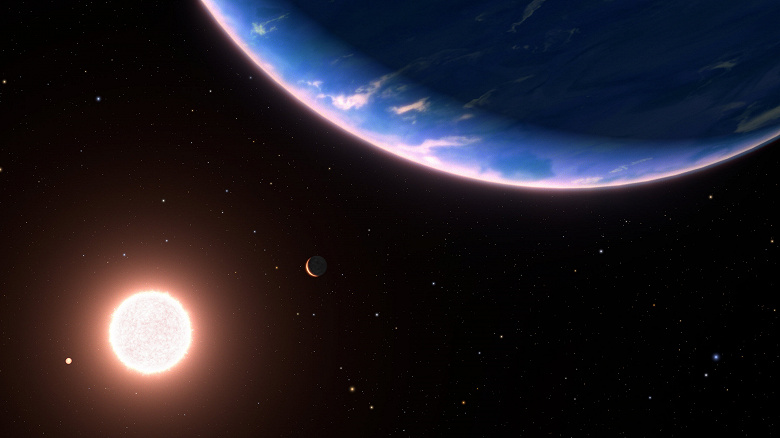Exoplanet GJ 9827d is the first direct evidence of watery atmospheres around other stars
Using the Hubble Space Telescope Scientists have observed planet GJ 9827d, which is only twice the size of Earth, and determined that it has an atmosphere rich in water. This is one of the new examples of potential planets with watery atmospheres in other galaxies.
GJ 9827d was discovered in 2017 by the Kepler space telescope. It orbits the red dwarf every 6.2 days and is located 97 light-years from Earth in the constellation Pisces.
«This may be the first time we can directly show that planets with water-rich atmospheres can exist around other stars. This is an important step towards determining the prevalence and diversity of atmospheres on rocky planets», — shared by research team member Bjorn Beneke from the University of Montreal.
At present, it remains unclear whether «Hubble» spectroscopically, the small amount of water vapor in a hydrogen-rich atmosphere, or the planet's atmosphere is largely composed of water remaining after the primordial hydrogen- and helium-rich atmosphere evaporated under the influence of stellar radiation.
«The observation program was specifically designed to not only detect molecules in the planet's atmosphere, but also search for water vapor. Either result would be significant, be it the dominance of water vapor or even a small amount in a hydrogen-dominated atmosphere», — noted the lead author of the article, Pierre-Alexi Roy from the University of Montreal.
«Until now, we have not been able to directly detect the atmosphere of such a small planet. As we study the smaller planets, there should be a transition where these small planets will no longer have hydrogen, and their atmospheres will be more like Venus (which is dominated by carbon dioxide)», — Beneke added.
Although the planet GJ 9827d has a very high temperature, approximately +425 °C, it would be uninhabitable even if the atmosphere were predominantly composed of water vapor. < /p>
Now the team has two options. The planet may still have a gaseous envelope rich in hydrogen and containing water. Perhaps it is «warm» version of Jupiter's moon — Europe, which has twice as much water under its crust as on Earth. «Planet GJ 9827d may consist of half water and half rock. And there may be a lot of water vapor at the top of this small rocky body— Beneke stated.
If the planet's atmosphere contains excess water, then most likely it should have formed further from its star, where the temperature is cold and the water is in the form of ice. In this scenario, the planet then migrated closer to the star and received more radiation. The hydrogen was heated, escaping, or is still escaping due to the planet's weak gravity. An alternative theory is that the planet formed closer to the hot star, which would explain the presence of water in the atmosphere.
«Hubble» observed the planet during 11 transits — events when a planet crosses a telescope's view of a star. These observations were carried out at different periods of time over three years. During transits, starlight passes through the planet's atmosphere and carries the spectral imprint of water molecules. If there are clouds on the planet, they are low enough in the atmosphere that the atmosphere is not completely hidden from the view of Hubble. and water vapor above clouds can be examined.
So, the «Hubble» observation opens the door to a more detailed study of this planet. It makes an excellent target for the James Webb Space Telescope, which can use infrared spectroscopy to search for other molecules in the atmosphere.

